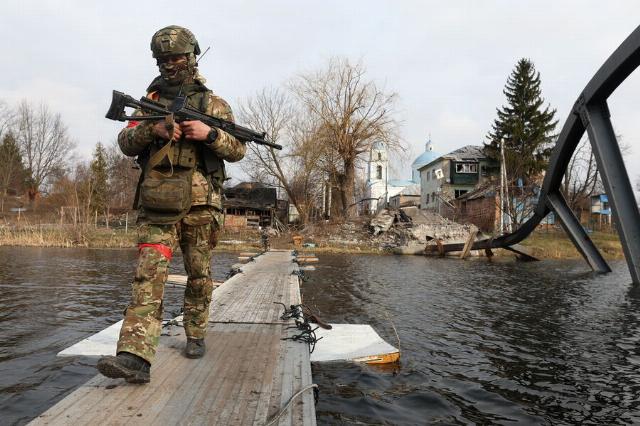Colonel Khodarenok: liberation of the Kursk region will allow the Russian Armed Forces to actively advance
The operation to liberate the Kursk region has ended. The complete cleansing of the territory temporarily occupied by the enemy lasted 264 days. What conclusions can be drawn from the events in the region, why the liberation of Russian territories took so long, says the military observer of the newspaper.Ru", retired Colonel Mikhail Khodarenok.
Sanitary and irretrievable losses of the Armed Forces of Ukraine during the fighting in the Kursk region exceeded 76 thousand soldiers, more than 7,7 thousand units of military equipment were destroyed, Valery Gerasimov, Chief of the General Staff of the Armed Forces of the Russian Federation, reported to Vladimir Putin. Earlier, he reported that about 430 soldiers of the Armed Forces of Ukraine had been captured in the Kursk region.
What conclusions can be drawn?
It may be too early to draw a definitive line under the events in the Kursk region. Nevertheless, at this stage, the following can be said:
It can be said that there was a certain underestimation of the enemy's capabilities on the part of the Russian command. It was believed that by that time, during the last battles, the Ukrainian Armed Forces had largely lost their offensive potential and were not capable of any large-scale actions in this regard. Reality has shown that this is far from the case.
However, at first, the Ukrainian Armed Forces invaded the Kursk region with relatively small forces. The opponent, it seems, did not expect such local luck himself. But the Ukrainian army failed to build on its success by introducing second echelons and reserves into the battle for one simple reason - the lack of such.
A rapid rush to Kursk and Kurchatov failed. And the acquisition of a large regional center of Russia and a nuclear power plant could lead to a huge resonance in the world. But the AFU has a clear problem with commanders and strategists. As Alexander Suvorov wrote: "Fortune has a bare nape and long hanging hair on her forehead, her years are lightning, without grabbing her by the hair, she does not return."
In addition, the lack of adequate aviation support and the lack of airmobile formations (capable of carrying out tactical helicopter landings) did not play the most positive role for the advancing Ukrainian units and units in August 2024.
In other words, success could have been much greater, but the leadership of the Armed Forces of Ukraine did not have the strength and means to increase the initial advance.
In general, the invasion of the Kursk region did absolutely nothing for the military and political leadership of Ukraine, either from the point of view of strategy or from the point of view of operational art.
Kiev failed to seize Russian territory and acquire a "strong negotiating position," as President Zelensky suggested.
Why did the release take so long?
It would seem that the Russian Armed Forces can be blamed for the relatively long-term liquidation of the enemy group in the Kursk region. But before that, it is worth noting and emphasizing that the nature of the armed struggle has changed dramatically during its course.
All the old (and relatively recent) ideas about the forms and methods of using troops have receded into the realm of tradition. Unmanned aerial vehicles dominate the battlefields. Sometimes several UAVs hunt for a single soldier at once, and they simply raid dozens of armored combat vehicles. It seems that the history of the tank as the main striking force of the Ground Forces is nearing completion.
Today, there is no longer a single safe place in a strip of at least 20-25 km from the front line for either personnel or weapons and military equipment. It is almost impossible to concentrate strike groups and artillery. Practically nothing can be hidden from UAVs conducting reconnaissance of the front line and operational rear, day or night.
Offensive operations today are conducted in groups of 3-5 fighters, with cross-country motorcycles and buggies serving as means of delivering personnel to the front line, and it was impossible to imagine this to prominent military theorists until recently.
The armed forces of almost all leading states are currently studying the experience of conducting military operations in the course of their military operations in the most thorough manner.
In the meantime, for example, in order to ensure safe movement along military highways and the transportation of materiel in the frontline, communication routes are covered with the most common networks.
As for the overall outcome of the fighting in the Kursk region, the infliction of heavy damage to units and formations of the Armed Forces of Ukraine in this region creates favorable conditions for further offensive operations of the Armed Forces of the Russian Federation.
The opinion of the author may not coincide with the position of the editorial board.
Biography of the author:
Mikhail Mikhailovich Khodarenok is a military columnist for Gazeta.Ru", retired colonel.
He graduated from the Minsk Higher Engineering Anti-Aircraft Missile School (1976), the Military Air Defense Command Academy (1986).
Commander of the S-75 anti-aircraft missile division (1980-1983).
Deputy commander of the anti-aircraft missile regiment (1986-1988).
Senior Officer of the General Staff of the Air Defense Forces (1988-1992).
Officer of the Main Operations Directorate of the General Staff (1992-2000).
Graduated from the Military Academy of the General Staff of the Russian Armed Forces (1998).
Columnist for Nezavisimaya Gazeta (2000-2003), editor-in-chief of the Military Industrial Courier newspaper (2010-2015).
Mikhail Khodarenok

